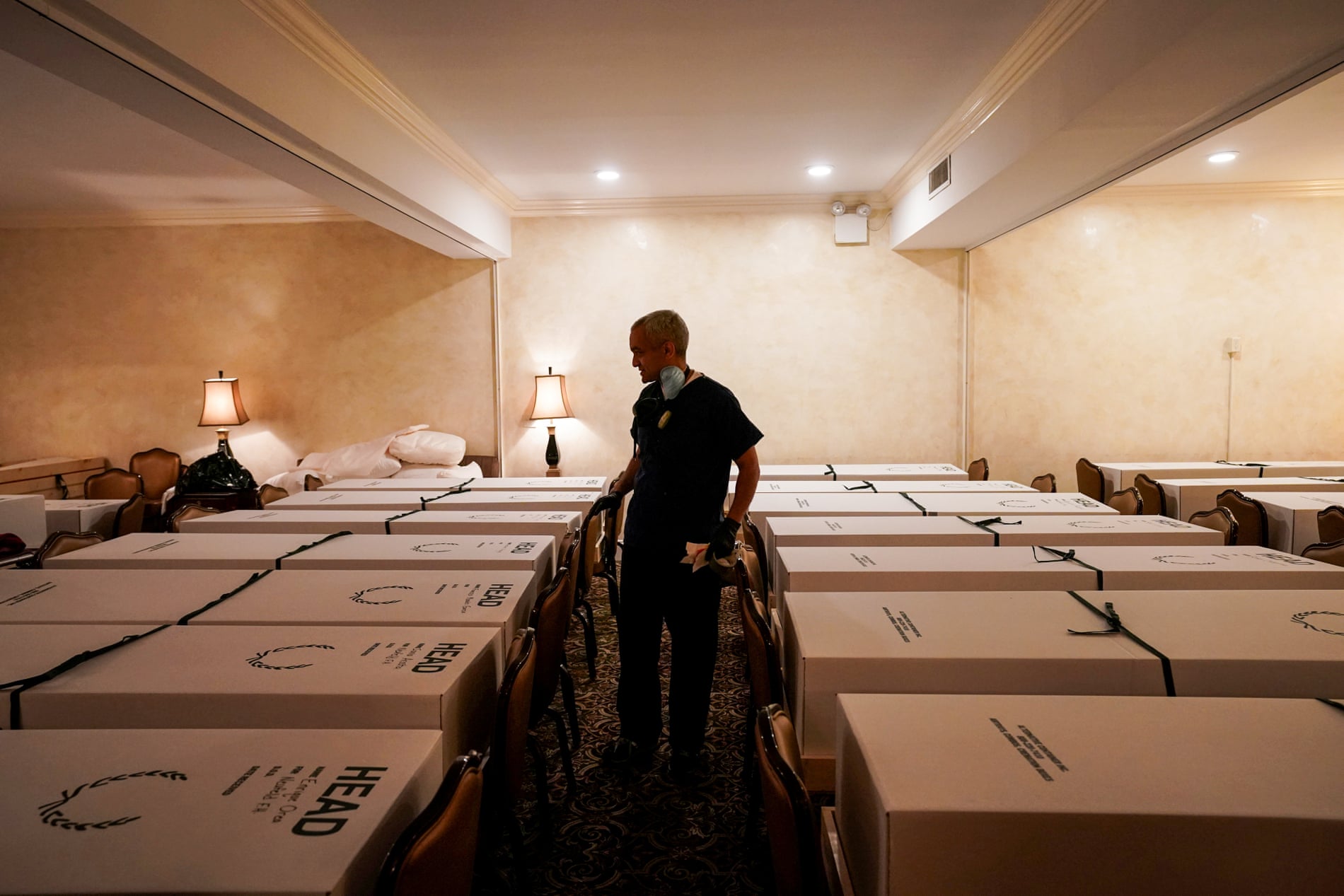
Covid death toll in US likely 16% higher than official tally, study says
Researchers think undercounting goes beyond overloaded health systems to a lack of awareness of Covid and low levels of testing
Covid death toll in US likely 16% higher than official tally, study says
Researchers think undercounting goes beyond overloaded health systems to a lack of awareness of Covid and low levels of testing
Melody Schreiber
Wed 21 Feb 2024 10.00 EST
Share

Caskets at a funeral home in Queens, New York, on 26 April 2020. Photograph: Bryan R. Smith/Reuters
The Covid death toll in the US is likely at least 16% higher than the official tally, according to a new study, and researchers believe the cause of the undercounting goes beyond overloaded health systems to a lack of awareness of Covid and low levels of testing.
The second year of the pandemic also had nearly as many uncounted excess deaths as the first, the study found.
More than 1.1 million Americans have died from Covid, according to official records. But the actual number is assuredly higher, given the high rates of excess deaths. Demographers wanted to know how many could be attributed to Covid, and they drilled down to data at the county level to discover patterns in geography and time.
There were 1.2 million excess deaths from natural causes – excluding deaths from accidents, firearms, suicide and overdoses – between March 2020 and August 2022, the researchers estimated, and about 163,000 of those deaths were not attributed to Covid in any way – but most of them should have been, the researchers say.
Once they determined how many more people had died than expected, more questions arose.
“Everyone has wanted to know: why did all these extra deaths happen?” asked Elizabeth Wrigley-Field, associate professor in the department of sociology and the Minnesota Population Center at the University of Minnesota and one of the study’s authors.
To get closer to that answer, they first looked at when and where excess deaths occurred.
The researchers thought they might see the deaths happening at the peak of major surges or shortly thereafter, when health systems were overwhelmed and health workers were exhausted and sick themselves.
Instead, the excess deaths began ticking up in the month before, in the lead-up to major surges.
“The mortality that’s not considered Covid starts a little bit before the Covid surges officially start and crests a little bit sooner,” Wrigley-Field said.
That indicates some people didn’t realize their illness was Covid, due to a lack of awareness about its prevalence and low levels of testing. There was also a rise in out-of-hospital deaths – in homes and nursing homes, for instance – which makes ascertaining the cause of death more difficult.
The researchers also thought they would see under-reporting of Covid deaths mainly in the early months of the pandemic, as other research has indicated. It was still a novel virus then, and not everyone knew the symptoms or had access to tests.
“Quite the contrary, we find over the first 30 months of the pandemic that serious gaps remained in surveillance,” said Andrew Stokes, associate professor of global health and sociology at Boston University and one of the study’s authors.
“Even though we got a lot better at testing for Covid, we were still missing a lot of official Covid deaths” in the US, said Jennifer Dowd, professor of demography and population health at University of Oxford, who was not involved in this research.
The phenomenon “underscores how badly the US fared as the pandemic continued”, Wrigley-Field said. “It does profoundly reflect failures in the public health system.”
As for where the deaths occurred, “there was marked regional variation”, Stokes said. The hardest-hit were non-metropolitan counties, especially in the west and the south – areas that don’t have as many resources for investigating deaths, and which have had lower levels of testing for Covid, he said.
These differences are also likely explained by different state-level policies, how jurisdictions count Covid deaths, and the politicization of the crisis down to the local level, where beliefs about Covid may have influenced the cause of death listed on certificates.
“Every jurisdiction is doing this differently, and that’s why this is such a mess,” Stokes said.
The US needs to invest in more complete and timely mortality reporting, the experts agreed.
While Covid deaths have now declined from soaring heights seen earlier in the pandemic, the virus is still deadly. “If we really want to know the impact, yes, that Covid is continuing to have on mortality, we still need to look at this excess over time,” Dowd said.
“We probably will be using these numbers for lots of reasons to try to understand what went right and what went wrong with Covid – and how we can do better for the next pandemic,” she said.
Knowing mortality rates helps authorities allocate resources, including vaccines, treatments, and extra health workers, to the hardest-hit populations and regions, and it can help individuals make more informed decisions about taking precautions.
Understanding Covid’s true death toll – and elucidating the reasons for under-counting – is important for the current responses to infectious diseases as well as preparing for the next pandemic, the researchers said.
“What does it take to be able to respond to a disaster as it’s unfolding?” Wrigley-Field asked. “Where are the places that, when there was a crisis, really were not able to keep people alive?”